A few months ago, I organised a competition on my blog and (so far) 18 lucky readers have received a book prize. The book contains a collection of recipes that represent the islanders' daily cooking, as well as some more festive fare and some taverna choices that are regularly offered on the menu. I asked the lucky recipients if they could make something from the book and send me a photo. In this post, I showcase what I have been sent so far.
I've named the participants' photos after the country they live in, to show the range of countries covered by the prize. This tried to address one of the problems being faced presently in Greek tourism: Greece needs to become better known to a wider range of people (eg Russians, Chinese, Americans) than she so far is (ie English, Germans, Scandinavians), and she needs to become known for the alternatives she offers (eg agro-tourism, eco-tourism, gastro-tourism), rather than what she is generally known for (eg Acropolis, Santorini/Mykonos, moussaka). Cretan cuisine, meaning the gastronomy of the island of Crete, is now becoming more of a catchphrase, as can be assumed in the following excerpt:
The one of Greece's most eminent poets, tourists, take heed:
 Northern Ireland was the first person to send me his contribution. He made a Greek rather than Cretan classic: spanakopita. Greens are a very important component of Cretan cookery, as we learnt from Eleni Tourlouki (view from the 43rd minute) at the First Symposium on Greek Gastronomy, who presented research showing that, despite dietary changes attributed to global trends (eg increased consumption of fast food), greens and vegetables, together with olive oil, still dominate in Cretan cuisine, by forming the basic food in the daily Cretan diet.
Northern Ireland was the first person to send me his contribution. He made a Greek rather than Cretan classic: spanakopita. Greens are a very important component of Cretan cookery, as we learnt from Eleni Tourlouki (view from the 43rd minute) at the First Symposium on Greek Gastronomy, who presented research showing that, despite dietary changes attributed to global trends (eg increased consumption of fast food), greens and vegetables, together with olive oil, still dominate in Cretan cuisine, by forming the basic food in the daily Cretan diet.
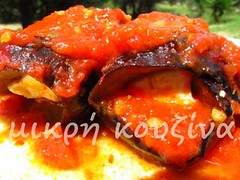 I particularly liked Greece's contribution, because it came at a time when I was inundated with aubergines from the garden, and I simply needed a gentle reminder of more interesting (and artistic ways) of using eggplant. This eggplant dish also uses a lot of fresh tomato (easily replaced by canned tomato, although admittedly, not the same thing!), another vegetable which we were blessed to have in plethora this year in the garden. The eggplant was stuffed with feta cheese, a good substitute when locally produced soft creamy Cretan mizithra is unavailable near you. In fact, mizithra is rarely available outside Cete because it doesn't store very well - except in the deep freeze, believe it or not, when it is freshly frozen in small packets, ie it's important to defrost as much as you will use in a short space of time. Many Cretans buy their mizithra from their favorite supplier (even straight from the farmer) and freeze it in small bags. This is handy because although mizithra is made all year round, the best tasting mizithra is made in spring and summer, which is only natural, as sheep stop producing milk in colder months (just like chickens stop laying eggs in winter).
I particularly liked Greece's contribution, because it came at a time when I was inundated with aubergines from the garden, and I simply needed a gentle reminder of more interesting (and artistic ways) of using eggplant. This eggplant dish also uses a lot of fresh tomato (easily replaced by canned tomato, although admittedly, not the same thing!), another vegetable which we were blessed to have in plethora this year in the garden. The eggplant was stuffed with feta cheese, a good substitute when locally produced soft creamy Cretan mizithra is unavailable near you. In fact, mizithra is rarely available outside Cete because it doesn't store very well - except in the deep freeze, believe it or not, when it is freshly frozen in small packets, ie it's important to defrost as much as you will use in a short space of time. Many Cretans buy their mizithra from their favorite supplier (even straight from the farmer) and freeze it in small bags. This is handy because although mizithra is made all year round, the best tasting mizithra is made in spring and summer, which is only natural, as sheep stop producing milk in colder months (just like chickens stop laying eggs in winter).
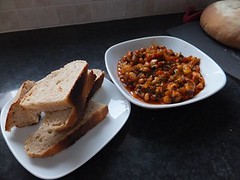 England also used eggplant to cook from the book. Her contribution combines aubergine with minced meat, another signature Greek dish. Papoutsakia are named after their shape - they look like 'little shoes', and these particular little shoes remind me of tsarouhia with their stems still attached! England prepared more than one recipe from the book: she also made yemista (another Greek dish - not pictured), and mavromatika (dry black-eyed beans), accompanied by bread. Such a combination - beans and bread, complemented by cheese - often makes a complete winter meal in Crete.
England also used eggplant to cook from the book. Her contribution combines aubergine with minced meat, another signature Greek dish. Papoutsakia are named after their shape - they look like 'little shoes', and these particular little shoes remind me of tsarouhia with their stems still attached! England prepared more than one recipe from the book: she also made yemista (another Greek dish - not pictured), and mavromatika (dry black-eyed beans), accompanied by bread. Such a combination - beans and bread, complemented by cheese - often makes a complete winter meal in Crete.
Holland also used the book more than once to create a meal. Holland is a vegetarian, so the book provided her with novel ideas for preparing meals that she is generally used to eating. But Holland went one step further: she did not necessarily follow the instructions in the recipes - instead, she followed the concepts of Cretan cuisine. Cretan cooking lays emphasis on fresh produce cooked/prepared with olive oil. Holland's meals look quite simple, as they can be made up on the spot, depending on what ingredients one has at their disposal: fresh vegetable produce and greens picked fresh from her garden may be eaten raw, or cooked lightly, eg par-boiling and steaming. Neither technique is particularly Cretan, but no one would realise this from Holland's photos: a Cretan would instantly recognise horta swimming in olive oil as classically Cretan, even if s/he doesn't recognise the actual species used. That's very important when cooking outside the island - snow peas may not be part of the Cretan diet, but that's the direction Cretan cooking would take if the cuisine is transplanted into a Northern European country!
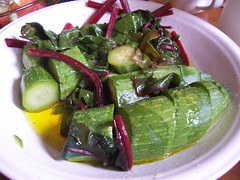
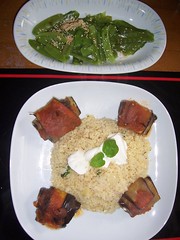
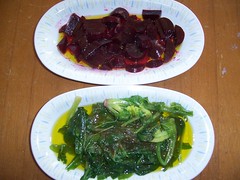
Holland also made eggplant rolls in tomato sauce (similar to Greece's contribution above, but without the cheese stuffing) which she serves with bulgur, and briam (aka tourlou-tourlou, a roast vegetable medley. But the dish that fascinated me the most was one that Holland didn't mention as coming from the book, as I was browsing her online photo collection. One of her 'creations' consisted of roast potatoes and boiled (?) zucchni, topped with some soft goat cheese and a light dressing of olive oil - Holland's very own version of boureki from Hania! Now that's what I call a good student of the Organically Cooked school!
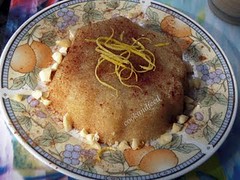 Finally, Canada's contribution reminds us that life is not all about savoury dishes: we also need to make our life more interesting with sweets! Like spanakopita, halva is a Greek (rather than Cretan) dish, and is still being made by home cooks and zaharoplasteia. During fasting periods, it's especially common, although it can also be made using milk which means it isn't lenten. At any rate, a semolina-based halva, the way Greeks make it, is a welcome afternoon snack (it can be made in individual dishes like ramekins), or a light dessert to round off a meal. It also goes really well with ice-cream, like a pudding.
Finally, Canada's contribution reminds us that life is not all about savoury dishes: we also need to make our life more interesting with sweets! Like spanakopita, halva is a Greek (rather than Cretan) dish, and is still being made by home cooks and zaharoplasteia. During fasting periods, it's especially common, although it can also be made using milk which means it isn't lenten. At any rate, a semolina-based halva, the way Greeks make it, is a welcome afternoon snack (it can be made in individual dishes like ramekins), or a light dessert to round off a meal. It also goes really well with ice-cream, like a pudding.
Isn't the internet great, for being able to reach out in so many ways, to so many people, from so many places?
©All Rights Reserved/Organically cooked. No part of this blog may be reproduced and/or copied by any means without prior consent from Maria Verivaki.
I've named the participants' photos after the country they live in, to show the range of countries covered by the prize. This tried to address one of the problems being faced presently in Greek tourism: Greece needs to become better known to a wider range of people (eg Russians, Chinese, Americans) than she so far is (ie English, Germans, Scandinavians), and she needs to become known for the alternatives she offers (eg agro-tourism, eco-tourism, gastro-tourism), rather than what she is generally known for (eg Acropolis, Santorini/Mykonos, moussaka). Cretan cuisine, meaning the gastronomy of the island of Crete, is now becoming more of a catchphrase, as can be assumed in the following excerpt:
"International tourism arrivals at the country’s 13 main airports in theyear’s first seven months amounted to 6,458,612, against 5,874,144 in the same period last year. All airports posted an increase, except for Athens, which declined by 2.74 percent in the period."enerally speaking, tourists come to experience Athens, not Athenians (!) and tourist services in Athens are up and running during this month: strikes involving manpower on the streets are generally not organised at this time of year for similar reasons that the UK, oops sorry, I meant the English riots, don't succeed in torrential rain. If it's all a matter of climate, the idea of the principle behind such actions is seriously weakened...
The one of Greece's most eminent poets, tourists, take heed:
"When you set out on your journey to Ithaca,
pray that the road is long,
full of adventure, full of discovery...
And if you find her poor, Ithaka won't have fooled you.
Wise as you will have become, so full of experience,
you will have understood by then what these Ithakas mean.
Constantinos Cavafy, "Ithaka", 1911
*** *** ***
Crete is slowly becoming a gastro-travel destination. As Greek food blogger Ioanna writes:[Cretan cuisine] is one of the most imaginative cuisines Greece has to offer, as Crete is a large island with great terrain diversity and is blessed with very fertile soil. The only problem with Cretan recipes is the fact that they use distinctive local ingredients and are very hard to replicate outside of Crete, even in Athens, where there are several shops selling produce from the island. There are, however, clever ways to substitute the ingredients successfully. so that you will get as close a result to the original as possible.
 Northern Ireland was the first person to send me his contribution. He made a Greek rather than Cretan classic: spanakopita. Greens are a very important component of Cretan cookery, as we learnt from Eleni Tourlouki (view from the 43rd minute) at the First Symposium on Greek Gastronomy, who presented research showing that, despite dietary changes attributed to global trends (eg increased consumption of fast food), greens and vegetables, together with olive oil, still dominate in Cretan cuisine, by forming the basic food in the daily Cretan diet.
Northern Ireland was the first person to send me his contribution. He made a Greek rather than Cretan classic: spanakopita. Greens are a very important component of Cretan cookery, as we learnt from Eleni Tourlouki (view from the 43rd minute) at the First Symposium on Greek Gastronomy, who presented research showing that, despite dietary changes attributed to global trends (eg increased consumption of fast food), greens and vegetables, together with olive oil, still dominate in Cretan cuisine, by forming the basic food in the daily Cretan diet.  I particularly liked Greece's contribution, because it came at a time when I was inundated with aubergines from the garden, and I simply needed a gentle reminder of more interesting (and artistic ways) of using eggplant. This eggplant dish also uses a lot of fresh tomato (easily replaced by canned tomato, although admittedly, not the same thing!), another vegetable which we were blessed to have in plethora this year in the garden. The eggplant was stuffed with feta cheese, a good substitute when locally produced soft creamy Cretan mizithra is unavailable near you. In fact, mizithra is rarely available outside Cete because it doesn't store very well - except in the deep freeze, believe it or not, when it is freshly frozen in small packets, ie it's important to defrost as much as you will use in a short space of time. Many Cretans buy their mizithra from their favorite supplier (even straight from the farmer) and freeze it in small bags. This is handy because although mizithra is made all year round, the best tasting mizithra is made in spring and summer, which is only natural, as sheep stop producing milk in colder months (just like chickens stop laying eggs in winter).
I particularly liked Greece's contribution, because it came at a time when I was inundated with aubergines from the garden, and I simply needed a gentle reminder of more interesting (and artistic ways) of using eggplant. This eggplant dish also uses a lot of fresh tomato (easily replaced by canned tomato, although admittedly, not the same thing!), another vegetable which we were blessed to have in plethora this year in the garden. The eggplant was stuffed with feta cheese, a good substitute when locally produced soft creamy Cretan mizithra is unavailable near you. In fact, mizithra is rarely available outside Cete because it doesn't store very well - except in the deep freeze, believe it or not, when it is freshly frozen in small packets, ie it's important to defrost as much as you will use in a short space of time. Many Cretans buy their mizithra from their favorite supplier (even straight from the farmer) and freeze it in small bags. This is handy because although mizithra is made all year round, the best tasting mizithra is made in spring and summer, which is only natural, as sheep stop producing milk in colder months (just like chickens stop laying eggs in winter).  England also used eggplant to cook from the book. Her contribution combines aubergine with minced meat, another signature Greek dish. Papoutsakia are named after their shape - they look like 'little shoes', and these particular little shoes remind me of tsarouhia with their stems still attached! England prepared more than one recipe from the book: she also made yemista (another Greek dish - not pictured), and mavromatika (dry black-eyed beans), accompanied by bread. Such a combination - beans and bread, complemented by cheese - often makes a complete winter meal in Crete.
England also used eggplant to cook from the book. Her contribution combines aubergine with minced meat, another signature Greek dish. Papoutsakia are named after their shape - they look like 'little shoes', and these particular little shoes remind me of tsarouhia with their stems still attached! England prepared more than one recipe from the book: she also made yemista (another Greek dish - not pictured), and mavromatika (dry black-eyed beans), accompanied by bread. Such a combination - beans and bread, complemented by cheese - often makes a complete winter meal in Crete. Holland also used the book more than once to create a meal. Holland is a vegetarian, so the book provided her with novel ideas for preparing meals that she is generally used to eating. But Holland went one step further: she did not necessarily follow the instructions in the recipes - instead, she followed the concepts of Cretan cuisine. Cretan cooking lays emphasis on fresh produce cooked/prepared with olive oil. Holland's meals look quite simple, as they can be made up on the spot, depending on what ingredients one has at their disposal: fresh vegetable produce and greens picked fresh from her garden may be eaten raw, or cooked lightly, eg par-boiling and steaming. Neither technique is particularly Cretan, but no one would realise this from Holland's photos: a Cretan would instantly recognise horta swimming in olive oil as classically Cretan, even if s/he doesn't recognise the actual species used. That's very important when cooking outside the island - snow peas may not be part of the Cretan diet, but that's the direction Cretan cooking would take if the cuisine is transplanted into a Northern European country!



Holland also made eggplant rolls in tomato sauce (similar to Greece's contribution above, but without the cheese stuffing) which she serves with bulgur, and briam (aka tourlou-tourlou, a roast vegetable medley. But the dish that fascinated me the most was one that Holland didn't mention as coming from the book, as I was browsing her online photo collection. One of her 'creations' consisted of roast potatoes and boiled (?) zucchni, topped with some soft goat cheese and a light dressing of olive oil - Holland's very own version of boureki from Hania! Now that's what I call a good student of the Organically Cooked school!
 Finally, Canada's contribution reminds us that life is not all about savoury dishes: we also need to make our life more interesting with sweets! Like spanakopita, halva is a Greek (rather than Cretan) dish, and is still being made by home cooks and zaharoplasteia. During fasting periods, it's especially common, although it can also be made using milk which means it isn't lenten. At any rate, a semolina-based halva, the way Greeks make it, is a welcome afternoon snack (it can be made in individual dishes like ramekins), or a light dessert to round off a meal. It also goes really well with ice-cream, like a pudding.
Finally, Canada's contribution reminds us that life is not all about savoury dishes: we also need to make our life more interesting with sweets! Like spanakopita, halva is a Greek (rather than Cretan) dish, and is still being made by home cooks and zaharoplasteia. During fasting periods, it's especially common, although it can also be made using milk which means it isn't lenten. At any rate, a semolina-based halva, the way Greeks make it, is a welcome afternoon snack (it can be made in individual dishes like ramekins), or a light dessert to round off a meal. It also goes really well with ice-cream, like a pudding.Isn't the internet great, for being able to reach out in so many ways, to so many people, from so many places?
©All Rights Reserved/Organically cooked. No part of this blog may be reproduced and/or copied by any means without prior consent from Maria Verivaki.
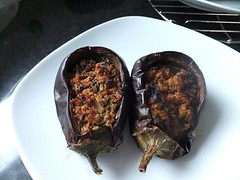
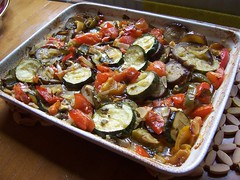
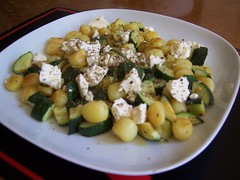
Eeep! My lazy butt made and photographed a dish (beef in red sauce? I forget the precise name), I just haven't sent it to you yet! I'll go upload it to Facebook so you can have it...
ReplyDeleteHi Maria,
ReplyDeleteI actually did my own translation of Ithaca a few years ago. Here it is:
http://crete.wordpress.com/2007/09/27/ithaca-c-p-cavafy/
Do I get a free cookbook now?
Ray.
http://recette1.blogspot.com/
ReplyDeleteThank you